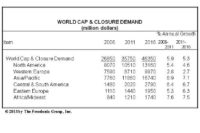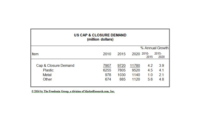U.S. Caps and Closures market to hit $4.26 billion in 2016
Offering
convenience, enhancing visual appeal, and facilitating brand diversification,
caps and closures are an integral component of packaging.
The U.S. caps and
closures market accounted for $2.70 billion in 2010 and is expected to hit
$4.26 billion in 2016, according the
Caps & Closures Market in the U.S.
report offered by Research and Markets. The market continues to evolve led by
rising consumer demand for higher protection and freshness standards.
Caps and closures can be defined by the materials from which they are produced, including plastic, metal, rubber, paperboard and cork. Plastic products dominated cap and closure demand overall. However, despite their overall noncyclicality, the cap and closure industry benefits during times of economic expansion and increased consumer spending.
The move away from metallic caps and closures towards plastic products is presenting new opportunities for designing of innovative caps and closures. The key areas of applications are beverage, food, personal care, pharmaceuticals, household and industrial chemicals (HIC), automotive, tamper evident (TE), continuous thread (CT), dispensing, dispensing pump/system, and child resistant (CR). A potential area of opportunity lies in the pharmaceutical industry, which continues to rely excessively on glass-based packaging.
Caps and closures can be defined by the materials from which they are produced, including plastic, metal, rubber, paperboard and cork. Plastic products dominated cap and closure demand overall. However, despite their overall noncyclicality, the cap and closure industry benefits during times of economic expansion and increased consumer spending.
The move away from metallic caps and closures towards plastic products is presenting new opportunities for designing of innovative caps and closures. The key areas of applications are beverage, food, personal care, pharmaceuticals, household and industrial chemicals (HIC), automotive, tamper evident (TE), continuous thread (CT), dispensing, dispensing pump/system, and child resistant (CR). A potential area of opportunity lies in the pharmaceutical industry, which continues to rely excessively on glass-based packaging.
Looking for a reprint of this article?
From high-res PDFs to custom plaques, order your copy today!






